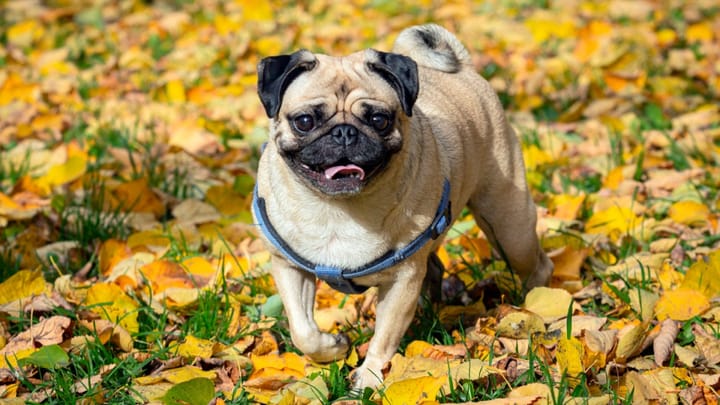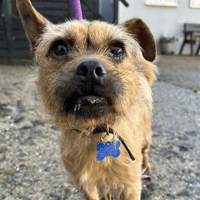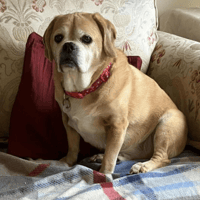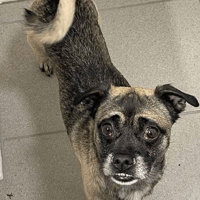Pug
Other name: Mops


Pugs are small and friendly dogs with great characters. Playful, affectionate and sociable, they are very pleasant life companions, especially suited to life in a flat. These little dogs enjoy the comforts of life and need love and attention to thrive!
|
Life expectancy |
The Pug has a life expectancy of between 12 and 15 years |
|
Temperament |
|
|
Size |
Small
|
|
Adult size |
Female
Between 10 and 13 in
Male
Between 12 and 16 in
|
|
Adult weight |
Female
Between 13 and 18 lb
Male
Between 13 and 18 lb
|
|
Coat colour
The coat can be silver, apricot, fawn or black. |
Black Blue Red Sand |
|
Type of coat
The coat’s hair is short. The coat is shiny, thin, smooth, and soft. The hair must not be hard, nor woolly, if the pug is to match the official standards of the breed. |
Short |
|
Eye colour
The eyes must be dark in colour. |
Brown
|
|
Purchase price |
The Pug costs between £670 and £850 |
Due to the reproduction of increasingly ‘exaggerated’ dogs (their muzzles increasingly flat), dogs of this breed are born with obvious impediments, given their heavy respiratory problems.
In this small hound, the condition causes quite significant snoring and a very loud sound as he breathes. This is mainly due to the narrowing and tightness of the nose. This may look amusing, but it is the result of a real malformation, caused by the unscrupulous efforts of some breeders to produce more and more pug-like pugs.
More details about the Pug
Pug: Origins and history
The pug’s heritage is ancient: he was created and bred in China (and was particularly valued among mandarins), but he is also very popular in Holland and England. These two nations have each claimed to be the creators of the race on the basis of the very good selection work they have done over many years. Finally, Britain prevailed and the paternity of the pug breed was attributed to those troubled isles. The pug may have experienced difficult times over the years, but today he is celebrated for his true value; however, potential owners should give serious thought as to whether they wish to encourage the breeding of these troubled brachycephalic beings.
Physical characteristics of the Pug
This small hound is "multum in Parvo" which translates as a big deal in a small space. His body is compact and chunky, and his musculature is visible. The Pug’s legs are neither too long nor too short, and he should not be skinny.
FCI classification of the Pug
-
Group 9 - Companion and Toy Dogs
-
Section 11 : Small Molossian type Dogs
Pug: Characteristics
Pug: Behaviour
Training a Pug
This dog is, against all odds, and contrary to common belief, easy to educate! You just need the right attitude and patience to get results.
Education should be firm and constant to compensate for his occasional stubborn side but you must never be brutal. Since he is very sensitive, the Pug needs an education based on respect of the principles of positive education: the reinforcement of good deeds and not the systematic sanction of the bad ones.
Finally, it is important to note that despite the small size of this dog, he must complete his schooling if he is to fit in to society.
In fact, small dogs are often not educated as much as large ones simply because the consequences of poor education are considered to be less dangerous. Regardless of what you have heard, this is incorrect and early education must be put in place, no matter the size of the dog.
Pug: Lifestyle
Breed compatibility Pug
Pug: Purchase price
The price of a pug varies depending on his origins, age and gender. An average of £850 is to be charged for a dog registered with Kennel Club.
The monthly budget allocated to the maintenance of the Pug is between £20 and £30 depending on the quality of the food chosen and taking into account occasion of his various annual treatments (vaccines, deworming, etc.).
Pug: Shedding
Average
This dog loses his hair continuously throughout the year. The rate of this loss is moderate but more intense during the moulting period in the autumn and spring. During moulting, brushing should be completed daily to remove dead hair.
Pug: Grooming
The maintenance of this small hound is not difficult but requires a certain regularity. His coat should be brushed weekly to maintain its brightness. In addition, special attention must be paid to his eyes, ears and the wrinkles of his nose.
Pug: Health
The lifespan of the pug is estimated at 13 years.
The chunky aspect of this hound could be interpreted as robustness, but this small dog is somewhat delicate, mainly because of his flattened snout.
However, besides this anomaly - a real complication in the pug’s life - the creature rarely falls ill.
Brachycephalia (flattened snout) is a cause of many respiratory complications. This dog does not have the same capacity as others to regulate his body temperature when he is hot.
When temperatures rise, Pugs are not able to sweat. Because of his flattened muzzle, it takes a more substantial effort to keep himself cool.
This dog does not have a thick undercoat to withstand the weather (cold, humidity). So he should never be left outdoors in such conditions. During winter walks, even the wearing of a coat may not be enough to protect his skin.
The unlimited appetite of this well-padded little dog can lead him to become much fatter than he should be. Even though he should not be skinny, neither should he be any rounder than necessary.
Be careful to feed him a diet adapted to the physical condition of his breed.
- Respiratory disorders, peculiar to brachycephalic dogs, meningoencephalitis-encephalitis (neurological pathology)
- Dermatological Infections due to wrinkles and creases in the skin
- Pseudo-hermaphroditism in males (abnormality of the genital tract)
- Difficulties during delivery
- Eye conditions
- Puppy's delicate growth
Do you want a Pug dog ?
4 comments
Are you sure you want to delete the comment?









